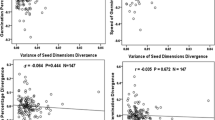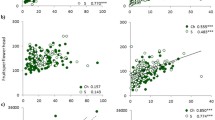Abstract
Related plants often produce seeds that are dispersed in very different ways, raising questions of how and why plants undergo adaptive shifts in key aspects of their reproductive ecology. Here we analyze the evolution of seed dispersal syndromes in an ancient group of plants. Ephedra (Gymnospermae; Gnetales; Ephedraceae) is a genus containing ≈50 species in semiarid ecosystems worldwide and with three distinct types of cones. We collected mature cones and seeds of ten species of Ephedra in southwestern United States and measured nine morphological traits for each species. Principal component analysis and other data characterized three types of Ephedra cones and seeds. Species with dry, winged cone bracts are dispersed by wind (i.e., E. torreyana and E. trifurca), those with succulent, brightly-colored cone bracts are dispersed by frugivorous birds (i.e., E. antisyphilitica), and those with small, dry cone bracts and large seeds are dispersed by seed-caching rodents (e.g., E. viridis and E. californica). Two species (E. funerea and E. nevadensis) have cone and seed morphologies intermediate between two seed dispersal syndromes. Seed and cones traits were mapped onto two recent phylogenies to help reveal the evolutionary history of seed dispersal syndromes. Bird dispersal is thought to be the ancestral form of seed dispersal in ephedras as it is common in the Old World where Ephedra originated, but the three North American species dispersed by birds are not monophyletic. The two wind dispersed species in North America also do not cluster together, suggesting separate origins. Seed dispersal by seed-caching rodents is common in North America and appears to have evolved several times, but this syndrome is absent form other continents. The evolutionary history of Ephedra in North America suggests that the means of seed dispersal has been malleable. Evolutionary shifts were likely linked to changes in ecological conditions.




Similar content being viewed by others
References
Benkman CW, Siepielski AM (2004) A keystone selective agent? Pine squirrels and the frequency of serotiny in lodgepole pine. Ecology 85:2082–2087. doi:10.1890/04-0177
Chambers JC, MacMahon JA (1994) A day in the life of a seed: movements and fates of seeds and their implications for natural and managed systems. Annu Rev Ecol Syst 25:263–292. doi:10.1146/annurev.es.25.110194.001403
Crane PR (1996) The fossil history of the Gnetales. Int J Plant Sci 157(6 Suppl):S50–S57. doi:10.1086/297403
Cutler HC (1939) Monograph of the North American species of the genus Ephedra. Ann Mo Bot Gard 26:373–428. doi:10.2307/2394299
Davidson DW, Morton SR (1984) Dispersal adaptations of some Acacia species in the Australian arid zone. Ecology 65:1038–1051. doi:10.2307/1938312
Freitag H, Maier-Stolte M (1989) The Ephedra-species of P. Forsskal: identity and typification. Taxonomy 38:545–556. doi:10.2307/1222629
Friedman WE (1990) Double fertilization in ephedra, a nonflowering seed plant: its bearing on the origin of angiosperms. Science 247:951–954. doi:10.1126/science.247.4945.951
Friedman WE, Carmichael JS (1996) Double fertilization in Gnetales: implications for understanding reproductive diversification among seed plants. Int J Plant Sci 157(6 Suppl):S77–S94. doi:10.1086/297405
Gendron RP, Reichman OJ (1995) Food perishability and inventory management: a comparison of three caching strategies. Am Nat 145:948–968. doi:10.1086/285778
Greene DF, Johnson EA (1989) A model of wind dispersal of winged or plumed seeds. Ecology 70:339–347. doi:10.2307/1937538
Hollander JL, Vander Wall SB (2004) Effectiveness of six species of rodents as dispersers of singleleaf piñon pine (Pinus monophylla). Oecologia 138:57–65. doi:10.1007/s00442-003-1393-2
Hollander JL, Vander Wall SB (2009) Seed dispersal in North American Ephedra. Int J Plant Sci 170:323–330. doi:10.1086/596334
Huang J, Price RA (2003) Estimation of the age of extant Ephedra using chloroplast rbcL sequence data. Mol Biol Evol 20:435–440. doi:10.1093/molbev/msg049
Huang J, Giannasi DE, Price RA (2005) Phylogenetic relationships in Ephedra (Ephedraceae) inferred from chloroplast and nuclear DNA sequences. Mol Phylogenet Evol 35:48–59. doi:10.1016/j.ympev.2004.12.020
Ickert-Bond SM, Wojciechowski MF (2004) Phylogenetic relationships in Ephedra (Gnetales): evidence from nuclear and chloroplast DNA sequence data. Syst Bot 29:834–849. doi:10.1600/0363644042451143
Jansen PA, Bongers F, Hemerik L (2004) Seed mass and mast seedling enhance dispersal by a neotropical scatter-hoarding rodent. Ecol Monogr 74:569–589. doi:10.1890/03-4042
Lanner RM (1998) Seed dispersal in Pinus. In: Richardson DM (ed) Ecology and biogeography of Pinus. Cambridge University Press, Cambridge, pp 281–295
Longland WS, Jenkins SH, VanderWall SB, Veech JA, Pyare S (2001) Seedling recruitment in Oryzopsis hymenoides: are desert granivores mutualists or predators? Ecology 82:3131–3148
Meyer SE, Kitchen SG, Wilson GR, Stevens R (1988) Proposed rule: Ephedra viridis green Mormon tea. Assoc Off Seed Anal Newsl 62:18–19
Price RA (1996) Systematics of the Gnetales: a review of morphological and molecular evidence. Int J Plant Sci 157(6 Suppl):S40–S49. doi:10.1086/297402
Price MV, Jenkins SH (1986) Rodents as seed consumers and dispersers. In: Murray DR (ed) Seed dispersal. Academic Press, Orlando, pp 191–235
Russo SE, Portnoy S, Augspurger CK (2006) Incorporating animal behavior into seed dispersal models: implications for seed shadows. Ecology 87:3160–3174. doi:10.1890/0012-9658(2006)87[3160:IABISD]2.0.CO;2
Rydin C, Pedersen KR, Friis EM (2004) On the evolutionary history of Ephedra: cretaceous fossils and extant molecules. Proc Natl Acad Sci USA 101:16571–16576. doi:10.1073/pnas.0407588101
SAS Institute Inc. (1989) SAS/STAT user’s guide, version 6, vol 1–2, 4th edn. SAS Institute Inc., Cary 943 pp
Smith CC, Fretwell SD (1974) The optimal balance between size and number of offspring. Am Nat 108:499–506. doi:10.1086/282929
Stapanian MA, Smith CC (1978) A model for seed scatterhoarding: coevolution of fox squirrels and black walnuts. Ecology 59:884–896. doi:10.2307/1938541
Stapf O (1889) Die Arten der Gattung Ephedra. Denkscr Kaiserl Akad Wiss Wien Math Nat Wiss Kl 56:1–112
Stevenson DW (1993) Mormon-tea or joint-fir family. In: Flora of North America north of Mexico, vol. 2; pteridophytes and gymnosperms, pp. 428–434
Thomson JD, Wilson P (2008) Explaining evolutionary shifts between bee and hummingbird pollination: convergence, divergence, and directionality. Int J Plant Sci 169:23–38. doi:10.1086/523361
Tomback DF, Linhart YB (1990) The evolution of bird-dispersed pines. Evol Ecol 4:185–219. doi:10.1007/BF02214330
Vander Wall SB (1990) Food hoarding in animals. University of Chicago Press, Chicago
Vander Wall SB (1992) The role of animals in dispersing a “wind-dispersed” pine. Ecology 73:614–621. doi:10.2307/1940767
Vander Wall SB (1993) Cache site selection by chipmunks (Tamias spp.) and its influence on the effectiveness of seed dispersal in Jeffrey Pine (Pinus jeffreyi). Oecologia 96:246–252. doi:10.1007/BF00317738
Vander Wall SB (2001) The evolutionary ecology of nut dispersal. Bot Rev 67:74–117. doi:10.1007/BF02857850
Vander Wall SB (2003) Effects of seed size of wind-dispersed pines (Pinus) on secondary seed dispersal and the caching behavior of rodents. Oikos 100:25–34. doi:10.1034/j.1600-0706.2003.11973.x
Vander Wall SB, Longland WS (2004) Diplochory and the evolution of seed dispersal. In: Forget PM et al (eds) Seed fate: predation, dispersal and seedling establishment. CABI Publishing, London
Vander Wall SB, Kuhn KM, Gworek JR (2005) Two-phase seed dispersal: linking the effects of frugivorous birds and seed-caching rodents. Oecologia 145:282–287. doi:10.1007/s00442-005-0125-1
Acknowledgments
We thank David, Jaylyn and Daphne Hollander, Kathryn Milliken and David Charlet for their help with seed collecting. Jeanne Chambers, Steve Jenkins, Bill Longland, Gene Schupp and Glenn Miller made helpful suggestions to improve the manuscript.
Author information
Authors and Affiliations
Corresponding author
Rights and permissions
About this article
Cite this article
Hollander, J.L., Vander Wall, S.B. & Baguley, J.G. Evolution of seed dispersal in North American Ephedra . Evol Ecol 24, 333–345 (2010). https://doi.org/10.1007/s10682-009-9309-1
Received:
Accepted:
Published:
Issue Date:
DOI: https://doi.org/10.1007/s10682-009-9309-1




